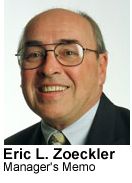 |
|
|
YOUR
COUNTY.
|
YOUR
BUSINESS JOURNAL.
|
Published October 2004
Case
studies: Putting
team reward plans to work
 Q.
Ours is a highly team-oriented engineering company. For us, Team “M” works
on a mechanical engineering project; Team Roadie, of course, handles the
road and highway construction contracts we’ve been awarded; and so on
throughout the company. We also thrive on employee rewards and recognition
as a motivating tool. How is rewarding entire teams different than individuals?
Q.
Ours is a highly team-oriented engineering company. For us, Team “M” works
on a mechanical engineering project; Team Roadie, of course, handles the
road and highway construction contracts we’ve been awarded; and so on
throughout the company. We also thrive on employee rewards and recognition
as a motivating tool. How is rewarding entire teams different than individuals?
A. As the popularity and the steadfastness of workplace “teams” has grown, differentiating how to reward and recognize a group of people has frequently befuddled senior executives. There are relatively few guidelines that have gained notoriety over the years.
One firm rule in establishing a team reward plan is to direct it to “what you are trying to accomplish as a business,” says Jerry McAdams, author of “Rewarding Teams, Lessons from the Trenches.”
McAdams, a St. Louis-based consultant with Watson Wyatt Worldwide, also cautions that each plan must be individualized for the work team involved. “There are no cookie-cutter formulas,” he said.
But businesses can look at the success of others for ideas. One such plan is a strategic reward system adopted worldwide by Chase Manhattan Bank. The bank’s plan complements its heavy cultural emphasis on reinforcing extraordinary performance, recognizing desired behaviors and serving customers within a team-oriented environment.
Working within teams, Chase employees can be designated as “stars” on one of three levels based on their performance.
A “Service Star” status bestows public recognition to the employee along with a silver keepsake “star” pin.
A quarterly “Super Star” award goes to employees with repeated “star” recognition or those who have met with extraordinary achievement. “Super Stars” receive a $750 bonus, a gold star pin and are invited to the annual “Super Star” banquet.
At years end, 125 of the “Super Star” winners are designated to be in the “Circle of Stars,” which earns them $5,000, a trophy and bankwide publicity and recognition.
Each “Circle of Stars” winner is brought to the New York City headquarters to participate in a leadership conference with senior and top management.
The uniqueness of the Chase plan is that employees, not executives, manage it. Peer review committees choose the award winners based on “blind” testimonials. The philosophy is who is best able to choose the best in a team setting — teammates, of course.
South Dakota-based Great Plains Software, a Microsoft subsidiary, provides an interesting case study for companies interested in adding incentives for teams involved with projects. The company develops specialized software for companies throughout the world, and its project teams are together for about six to nine months.
Teams are rewarded based on their performance in meeting deadlines and designing “bug free” software.
“Everything they do at Great Plains Software is wrapped up around those objectives,” McAdams said.
Rewards vary. For noncritical projects, a job well done may earn team members a thank-you letter or a celebratory social event. For more critical projects, cash awards of “a few hundred dollars” are distributed along with special recognition awards for individual achievements.
Do such programs pay off? Great Plains points to its less than 3 percent annual turnover as proof it’s doing something right.
Eric Zoeckler operates The Scribe, a business writing service with many Snohomish County-based clients. He also writes a column on workplace issues in The Herald on Mondays. He can be reached at 206-284-9566 or by e-mail to mrscribe@aol.com.
© 2004 The Daily Herald Co., Everett, WA








